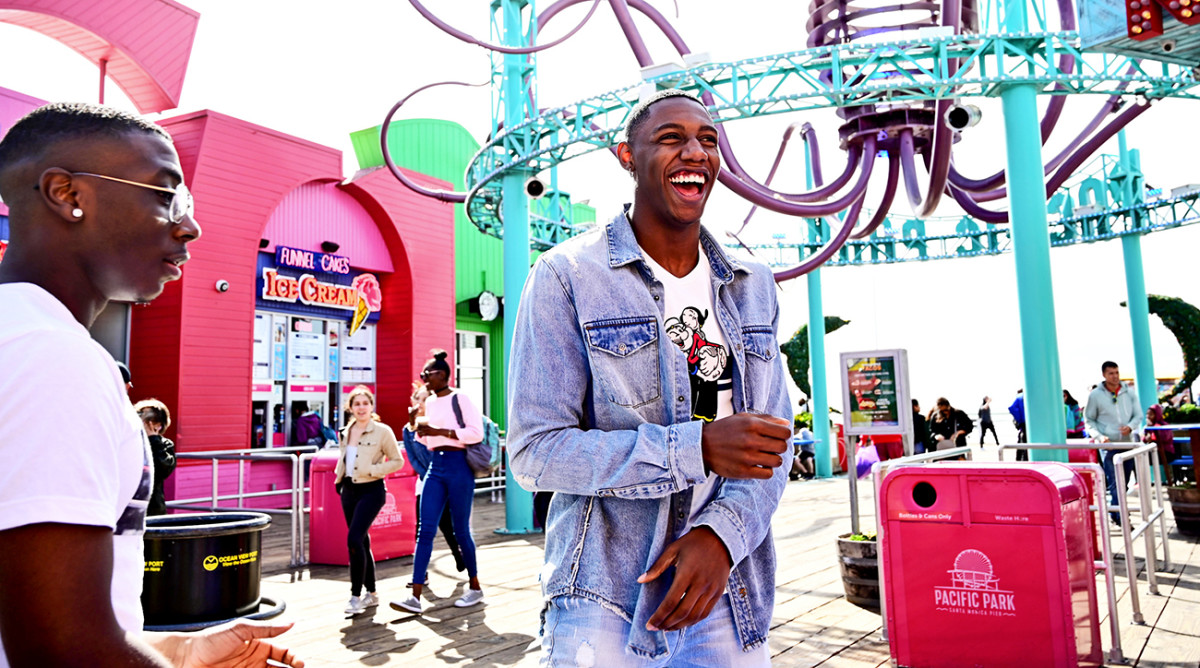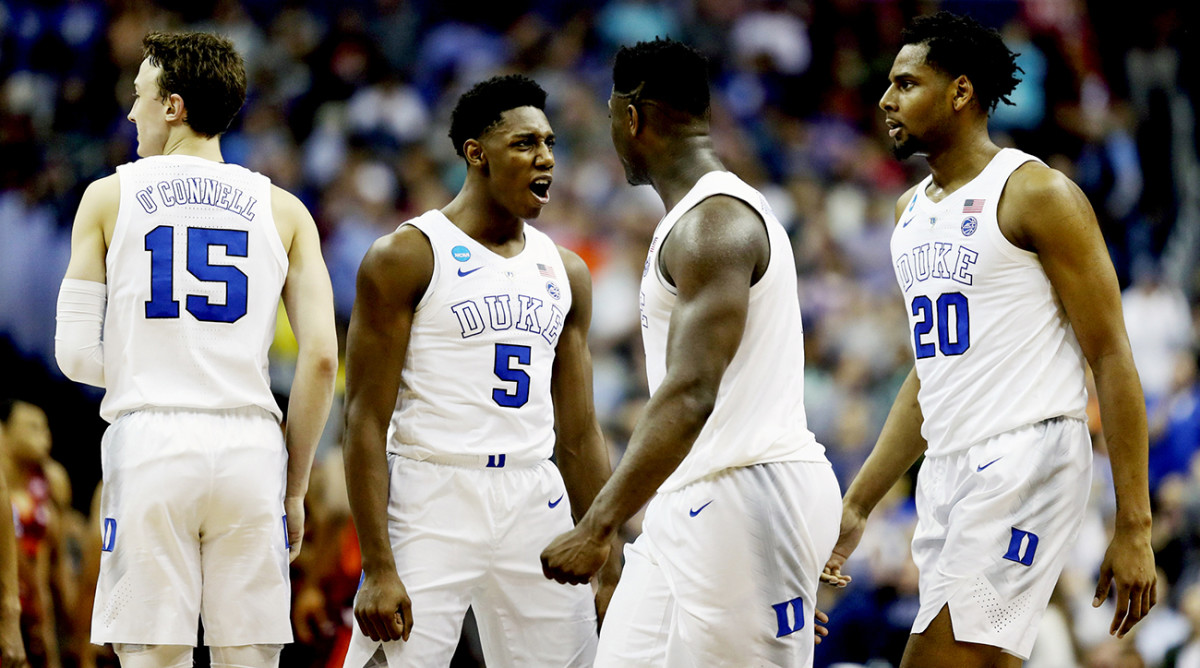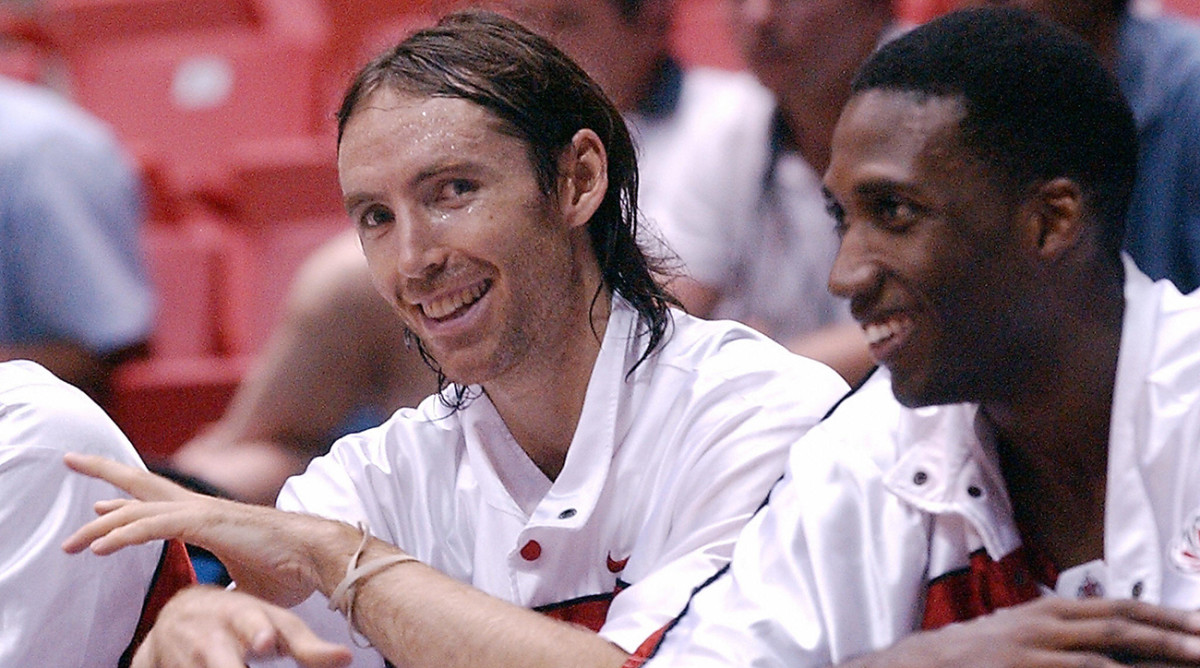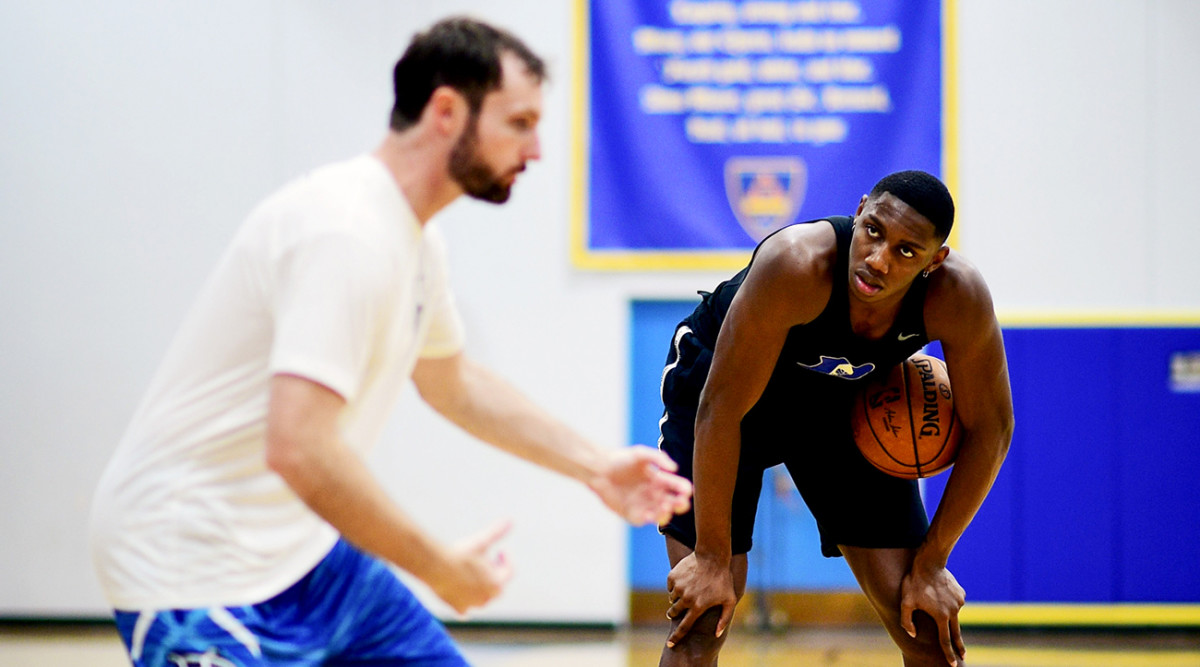Canada's Other Success Story: R.J. Barrett is Ready to Take Center Stage

The Santa Monica Pier is one of the most well-worn tourist spots in all of California, but for R.J. Barrett, two hours among strangers was a welcome opportunity to relax and blend into the crowd. So, in between two-a-day workouts one afternoon in late May, he brought some friends from Toronto and we met up at the boardwalk’s mini-amusement park. We ate hot dogs and funnel cakes (his funnel cake was made of churros), we rode a small roller coaster (the West Coaster) and we jumped on a hydraulic tower that went 44 feet in the air before dropping us straight down (the Pacific Plunge). He shot carnival free throws (he won a stuffed L.A. Chargers pillow), he argued about pools versus the ocean (he doesn’t trust the latter, and refuses to risk his life snorkeling), and he declined to join in on the Inkie’s Scrambler, an octopus-themed, spinning teacup sort of thing. “Come on,” he said, “that’s five-year-old stuff.”
Later this month Barrett is likely to be a Top 5 pick in the draft. He may go as high as No. 3 to the Knicks. “New York,” he says, “playing in the Garden, I’ve always been a player who likes to play with a lot of people watching. It's not the same as Cameron [Indoor Stadium], but that kind of vibe. The fans are great every single game. I love that.”
Last year he costarred with Zion Williamson at Duke on one of the most magnetic college basketball teams of the past decade. "Everybody already knows that's my brother," he says of Zion. The two lottery picks were roommates in Durham. They still talk all the time, but R.J. says they don’t broach the draft possibilities. “Off the court,” he says, “we don’t even care. We just talk about kids stuff.” That’s the way their relationship has always been. “It’s funny the way we connected,” says Barrett. “We talked about everything except basketball.”

Barrett’s time in the spotlight began even before he got to Duke. A 6' 7" combo guard, his name has been a fixture in basketball circles since he was in middle school. Born in Toronto and eventually raised outside the city in Mississauga, Ont., he’s arguably the most heralded basketball prospect in the history of Canadian hoops. His father, Rowan, played professionally throughout Europe and South America. Rowan Junior—R.J.—was three months old when his dad was in Sydney as the captain of the Canadian Olympic basketball team. After his playing career finished, Rowan Sr. spent years working with the national team. He’s now the general manager of the Canadian national program. His dad’s close friend on that 2000 Olympic team, Steve Nash, is R.J.’s godfather.
“He’s becoming an adult before our eyes,” Nash says. “With all he’s gone through and what’s been thrown at him—as a human, it’s awesome to see him grow. As a basketball player, that’s just been out of this world.”
While Rowan Sr. was still playing abroad in Europe, R.J. spent his first eight years excelling in soccer and lingering on the court after his dad’s basketball games. Rowan wasn’t the only athlete, though. R.J.’s mother, Kesha, was a nationally ranked sprinter and long jumper in college. His grandparents ran track competitively in Jamaica. His aunt was a member of Jamaica’s 4×100 relay team that won gold in the 1991 world championships. His uncle played college football at Maryland.
R.J.’s parents were reluctant to push him toward one sport, but in the end they couldn’t keep him away from basketball. A few years after his family moved back to Canada, he learned to love the Raptors. He visited his godfather during the Western Conference finals in 2010 and slowly realized what he wanted to do with the rest of his life. By age 11 he decided to give up soccer and begin training full-time to be a professional basketball player. That meant workouts before school, after school and sometimes during lunch.
His dad says he was uneasy about the transition at first. “Soccer’s good for basketball too,” he told R.J. “All the give-and-gos, the endurance. . . . What are you trying to accomplish in basketball if you’re going to quit soccer to do it?”
“Dad, I’m going to be an NBA champion,” R.J. told him. “I’m going to be an NBA All-Star. One day I want to be in the Hall of Fame.”
“O.K.,” Barrett Sr. said. “Hold on.” They went to a hardware store. They bought a whiteboard for his bedroom wall. Then they started writing. NBA champion. All-Star. No. 1 pick. As Barrett Sr. said, “If you want to be that kind of guy, you might have to go to one of these big schools, be on the highest level of competition. What school is it?” So R.J. started reeling off those names. Duke. North Carolina. Kentucky. Then his dad said that, usually, the kids that go to those schools play in the McDonald’s All-American Game.
“Put it on there,” R.J. said.
“We just kept rolling, one by one,” his dad remembers. “His first major goal was that at age 14 he wanted to be the No. 1 player in Canada, and he wanted to be in the top 10 in the United States. And then, by 13, he was No. 1 [overall]. He held that spot through the end of high school.”

At Duke last year Barrett’s storybook rise became more complicated. He arrived in Durham projected to be the No. 1 pick in the 2019 draft. Four months later his roommate was the biggest story in sports, the face of the program and the presumptive top pick in the draft. Barrett was left to spend the year navigating defenses that packed the paint with extra defenders and dared the other Blue Devils to shoot from the outside. He struggled from the perimeter (30.8% from three), and as the year unfolded he faced heightened scrutiny about what he might become at the next level. Duke won the ACC tournament, but as the top seed in the NCAA tournament the Blue Devils lost in the Elite Eight to Michigan State. The 68–67 defeat was sealed when Barrett missed a free throw with six seconds to play.
Barrett has no regrets. “I felt bad for teammates,” he says. “I felt like I let my team down. But [then it was] just trying to remember how much of a great season we had. It was so much fun.
And it’s funny, as soon as we landed back in Durham, it was forgotten. We went right back to being friends and teammates.” Asked whether it was difficult seeing Williamson overtake him as the No. 1 pick last year, Barrett is almost offended: “What? No! I’m happy for him. That’s literally my roommate. We would go [into every game] like, ‘Yo, we’re both killers. This is fun.’ ”
In a universe without an NBA age minimum, Barrett could have gone pro right out of high school. He’s glad he wound up at Duke instead. “A college experience is something everyone should have,” he says. “Going to Waffle House late at night. Or the gym at midnight, until the wee hours of the morning. Just being kids. Hanging out. Playing video games, trying to beat [teammate] Tre [Jones] at Fortnite.”
On the floor, at 18 years old, Barrett averaged 22.6 points, 7.6 rebounds and 4.3 assists. According to ESPN’s DraftExpress, whose database goes back to 1980, no teenager has ever matched that line. He was excellent, and so was Duke, and it should be clear that all criticisms are relative. But criticisms came nonetheless. Such is life for a top-five draft pick. As a nation of basketball fans tuned in to watch Zion, they were just as likely to see Barrett crashing into a crowded lane and wonder why he wasn’t passing. “A lot of people overreacted,” says skills coach Drew Hanlen, who’s been working with Barrett since his sophomore year in high school. “Like, ‘Oh, he’s a selfish player.’ ”
When the Blue Devils won, Zion was the story. When they lost, everyone focused on R.J., and critics noted that despite his counting stats, his shooting and efficiency metrics were ordinary. He entered college drawing comparisons with James Harden, and he left school with scouts wondering if he might be closer to Tyreke Evans.
His godfather finds a lot of those worries to be overblown. “Duke had a great team," Nash says. “Obviously it's a pleasure and a privilege to play for Coach K. But they weren't a great shooting team. And college basketball is much more clogged, so to speak. Because of the rules, the three-point line, the caliber of shooting. It is tougher, in some ways, than the NBA game. [In the NBA] you can't camp out in the lane, there's shooters everywhere, the line is deeper.”
“It’s really important to remember he’s 18,” Nash says. “You have to project where he’ll be in a few years. The way he’s trended the past few years has been phenomenal. His shooting is getting better and better. He’s gotten bigger and stronger and more athletic. I think he still has some growing to do. And then the most exciting part, for me, is he’s a talented playmaker. He’s a guy in today’s NBA who can make plays for his teammates and be so potent flashing to the basket and creating shots for himself. Those players are so valuable. They can play multiple positions, and eventually I project that he’ll guard multiple positions. It just takes time.”

Barrett Sr. first met Nash when they were teenagers on the Canadian junior national team. At 16, Nash was two years younger than almost everyone else when he flew from Victoria, B.C., and found himself thrown into a locker room full of players from Toronto. “It was a whole new world,” Nash says. He learned slang he’d never heard, he visited areas of Toronto he’d never seen, he ate Jamaican patties, and he followed Rowan’s lead. “He was very inquisitive,” Barrett Sr. says. “He wanted to embrace our culture.”
Barrett learned from Nash just the same, and as he recounts lessons in British culture, he breaks into a British accent and an impression of Nash’s father, a professional soccer player. “Work rate! Work rate!” John Nash used to yell from the sideline. “Steven . . . work rate.”
The teenagers’ bond solidified on the court. “Throwing alley-oops,” Barrett says, “wearing baggy shorts, in a time when it wasn’t very fashionable to do that up [in Canada]. We were just kindred spirits. I was an athlete, I could run, and he lived to hit you on the break. He was the best shooter on the team, even then, but he was always trying to feed everybody.” Eventually Nash asked his parents if he could stay with Barrett during national team sessions in Toronto. “He made me feel at home,” Nash says. “And comfortable with a bunch of guys I’d never met before.”
When R.J. was born years later, his dad had to look around and think: “What if I wasn’t around? Who would I want to model manners and responsibility to my son?”
Nash was the first name that came to mind, and he said yes to being godfather “within 10 seconds.” He bought a crib and a full set of baby clothes for R.J., and he did his best to keep in touch as the years passed. That process was hard when Rowan’s family was in Europe and Nash was in Dallas and Phoenix, but it became easier once Nash rejoined the national team and began returning to Toronto each summer. These days R.J. and Nash talk every few weeks, about the NBA, the draft process and finding balance amid the chaos that comes with both.
Barrett Sr. remembers one such conversation near the end of high school, when R.J. began to realize that heightened fame meant less privacy. He had to be more careful where he went and with whom. He leaned on Nash to process this new reality, and as his dad remembers it, Nash said, “You’re doing what you love. And when you have a bad day, just think about all that you’re fortunate to have. You’ll start to realize, it’s actually not that bad a day. It only takes five seconds to be a good person and be who you want to be. If somebody comes asking for an autograph, even if you can’t stop, it doesn’t cost you anything to smile.” Barrett Sr. breaks into laughter after recounting this anecdote. “I was just eating it up. I’m like, ‘Man, keep talking, Steve! Keep talking!’ ”
It wasn't always easy rising through youth basketball ranks in the shadow of a Dad prominently running involved in the national program. "I got made fun of a lot," R.J. says. "Like, 'Oh yeah, you're only here because your dad's the guy.' Blah, blah, blah." As his dad says, "I always heard that kind of stuff. I would ask him about it. 'Did it upset you? How does it feel?' My advice to him at the end was, 'Look, if you want to answer this, just win. Winning ends all discussions.' And I think, over time, the truth has always shown. Like, I can't play for him. I can't make any baskets for him." He laughs here. "All the NBA teams and everyone else that have him in this place, it has very little to do with me."
Barrett is now a headliner among a wave of Canadian talent that’s sweeping the basketball scene. There have been 27 Canadians in the NBA in the past 35 years, but 18 of those have arrived in the past decade. Canada now has the most NBA players born outside the U.S. (13), and this week's draft could feature as many as five Canadians picked in the first round. For a nation that could claim only Bill Wennington and Rick Fox when Nash entered the league in 1996, this is progress.
In 2017, Barrett led Canada to a gold medal at the under-19 FIBA World Cup in Cairo. It was the first time Canadian hoops had even played for a gold medal at any level since 1936. Against the John Calipari–coached U.S. team in the semis, Barrett put up 38 points, 13 rebounds and five assists against a team that included future pros such as P.J. Washington, Kevin Huerter, Hamidou Diallo and Cam Reddish.
As he hits the NBA, one of the opportunities he's most excited about is the chance to dispel any stereotypes about his countrymen. “That we're soft,” he says. “I'm not soft at all.” When talk turns to other Canadians in the NBA, Jamal Murray's name emerges. “Yeah,” Barrett says. "Like, he's not soft. You can't be playing the basketball that he is if you're soft."
“That's always been an uphill battle,” Murray says of Canadian stereotypes. “That's how it's been my whole my life.” We were speaking before Game 1 of the NBA Finals in Toronto, on a night when the entire nation was focused on the NBA, two weeks before Toronto won the title. The energy surrounding that Raptors run creates momentum that can continue with players like Murray and Barrett representing Canada over the next several years. “He has a great future,” Murray says of Barrett. “He's going to have a chance to shine. Real athletic guy, great kid. He's going to show his stuff out there.”
The trick will be embracing those expectations without becoming defined by them. The World Cup in 2017 solidified Barrett’s reputation as a future star. Many around basketball began talking about him as if he were Canada's answer to LeBron. Of course, around the same time, Andrew Wiggins, former-no. 1 pick and one-time future of Canadian hoops, was beginning to plateau in Minnesota. It's a trajectory that serves as a cautionary tale in hype and how it can affect a career.
“I don’t necessarily worry,” Nash says of the pressure that comes with Barrett’s pedigree, “because it’s a privilege for him to go through it. I think of the life lessons, the wisdom and the opportunity he’ll gain from this. [The key is] finding the competition within yourself, and at the same time, have a healthy relationship with exterior expectations. You understand it, you embrace it, but it doesn’t interfere with your own journey. At the end of the day you gotta live with yourself whether you become the greatest ambassador the game’s ever seen, or something less than that.”
All of that context lends Barrett's story a layer of intrigue that sets him apart from the rest of his draft class. His game is arguably more polarizing than any top prospect on the board, but as much as he'll be judged by true shooting percentages and defensive progress over the next several years, his story is also one of generational progress and the overnight arrival of a thriving basketball culture. His profile thus far is its own reflection of how far Canadian basketball come. Now he has the chance to lead the next generation even further.

Before settling in Ontario, Barrett spent the first half of his life in Europe, where his dad was playing. Then, by high school, he asked to leave his parents and live on his own in Florida, seeking out the competition offered at hoops powerhouse Monteverde Academy. That background may be why he seems unusually mature and polished for an 18-year-old. When he’s asked about the draft and where he might end up, for instance, he can already give pitch-perfect NBA veteran answers: “To be in the league and to finally fulfill my dream, that’s what I want.” Later, called out for giving the most diplomatic post-lottery answers imaginable, Barrett can’t help break out laughing and promise that he’s serious.
He’s most fun when he’s still acting like a kid. Like when I ask him which NBA player he'd want taking the last shot: "Shoot, it's looking like Kawhi right now. Right?" But then, after a dramatic pause: "KD. KD. I'm not going to lie to you. KD's tough." Or after a late-night workout with Hanlen, I get to watch an extended dispute over a recent game of one-on-one. At the end his trainer joked, “Oh, man, the things a Canadian has do to get a win over an American.” At which point Barrett threw up his hands, exhausted and incredulous, and cited his performance in Egypt: “I gave you guysforty!”
Hanlen has worked with Bradley Beal, Jayson Tatum, Joel Embiid and dozens of other NBA players. He met R.J. when Barrett was 15 years old and they’ve had semi-regular sessions ever since. As Hanlen remembers their first meeting, “I put him through a damn near blackout kind of workout. And then afterward he was like, ‘Damn, I’ve never gone through anything like that. Can I get a picture with you? Are we going to work together?’”
This spring and summer will be their longest stretch working together, and there are three priorities for Barrett along the way. The first is shooting—keeping his elbow in, going straight up and down—and improving consistency both off the catch and off the dribble. The second is shiftiness. As Hanlen says: “We know he can beat players, but a lot of times he was using his strength. That doesn’t work at the next level. We’re working on opening up his hips.” And the third priority is pace and balance. “A lot of times at Duke,” Hanlen says, “he was off-balance and he was forcing things. [We’re working on] him dropping his hips, being more upright with his shoulders, so that he can be more stable. We want to be prepared where he can stop on a dime when guys rotate over. Make a good pass or just shoot a little floater or jump shot. Make it easier.”
The people who believe in Barrett's future as a star will trust that development process and echo much of what Nash has emphasized. Having turned 19 just last week, R.J. is one of the youngest players in the entire draft. His ability to make plays for teammates and score at the rim are going to make him more dangerous in the NBA than he was at Duke. He can create matchup problems in transition, and if you look at the various offenses we just saw around the NBA playoffs, giant playmakers were everywhere. Giannis Antetokounmpo, Ben Simmons, Kawhi Leonard, James Harden, Jimmy Butler—all of them combine speed, power, size, and vision in much the same way Barrett will at the next level. His shooting weaknesses can be addressed over time, in large part because he works incredibly hard. All the sacrifices that NBA players have to make to be great, Barrett has been making for almost 10 years now.
The question that will decide his ceiling is how much of greatness can be engineered, and how much of a superstar guard's game is innate. Barrett can dive head first into training, he will work with skills coaches, and he's already built on several generations of family history and shouldered nearly a decade's worth of expectations. But when a coach like Hanlen emphasizes shooting and shiftiness and pace as the areas to improve, he's highlighting superstar qualities that are harder to explain. Touch, feel, and balance often seem like their own sort of intangibles. It's an open question as to how much of that can be developed in any traditional sense.
The one safe bet is that Barrett will continue to give himself every opportunity to succeed and embrace every challenge. In the middle of Pacific Park at the Santa Monica Pier, riding the Ferris Wheel, I asked him about expectations and pressure. He dismissed the notion that life as a prodigy has been any kind of burden. "It makes basketball more fun," he said. "To be the top guy throughout my life and my career, to have people coming at me every game, giving me their best shot. That's part of the reason I went to Duke. I love that stuff."
As for the work it took to get this far, he laughed remembering seventh-grade workouts before school, begging his father to let him stay in bed but showing up every day to continue working his way through the whiteboard. “It wasn’t easy,” he said. “But now I get to live the life that I want.”
